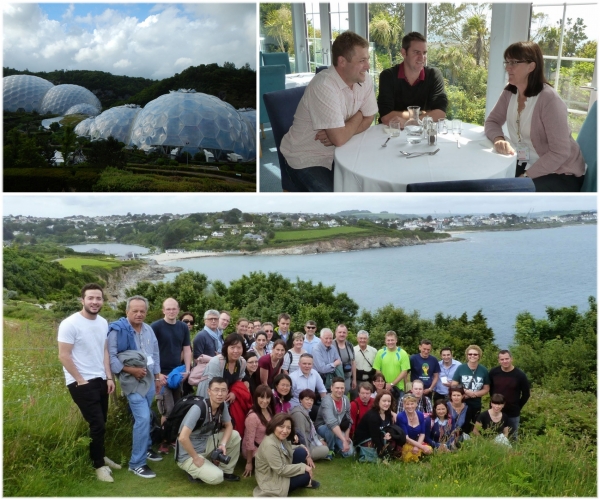CeBER attends Biohydrometallurgy 2014 and Sustainability through Resource Conservation and Recycling 2014, Falmouth, UK June 2014


Top Left: The Tropical (left) and Mediterranean (right) biomes of the Eden Project. Top Right: The CeBER Team of Dr Rob Huddy, Dr Rob van Hille & Prof Sue Harrison that attended the Biohydromet '14 & SRCR '14 conferences in Falmouth, Cornwall, UK. Bottom: Biohdromet '14 conference delegates enjoying a walk along a coastal path, with views of Swanpool Beach, the Atlantic Ocean and Falmouth town in the background.Photos courtesy of Barry Wills and Dr Rob Huddy
Report back from Dr Rob Huddy:
I recently attended two back-to-back conferences, Biohydrometallurgy 2014 (Biohydromet ’14) and Sustainability through Resource Conservation and Recycling 2014 (SRCR ’14) held in Falmouth, Cornwall, UK. Amongst the attendees were some of the biggest names in global biohydrometallurgy research, including Barrie Johnson, Corale Brierley and Paul Norris. Biohydromet '14 focused on the latest developments in the field of biohydrometallurgy, including the development, optimization and application of integrated biomining process operations for mineral ores, including low grade and complex ores; the microbiology of biomining and the application of biohydrometallurgy to novel resources (such as mine and electronic wastes) and the (bio)remediation of mining-impacted environments.
CeBER was represented at both conferences by Sue Harrison, Rob van Hille and myself, with Jenny Broadhurst joining us later in the week for SRCR ‘14. At Biohydromet ’14 Sue Harrison presented a paper on the effect of acid stress on mixed mesophilic microbial community and Rob van Hille presented a paper describing the effect of thiocyanate on the survival and adaptation of BIOX®-associated microorganisms. Thereafter, I presented a paper, on behalf of Cindy-Jade Africa, entitled “Thermophilic mineral-microbe interfacial environments explored: Insights into the building blocks of the Metallosphaera hakonensis biofilm.” Sue also presented a paper discussing the effect of physicochemical conditions on the growth and activity of Acidithiobacillus ferrooxidans on low grade chalcopyrite ore, with particular emphasis on heap leaching systems. All of the CeBER papers were well received by the audience and stimulated some lively questions and discussion.
In the evenings, we enjoyed a lengthy walk along a coastal path, with spectacular views of Falmouth and the river Fal. The walk ended in the 17th century pub, The Chain Locker, where the delegates enjoyed a traditional Cornish Ale or two. The conference dinner was held at the world famous Eden project. We were privileged to have exclusive use of the Eden Project and enjoyed a walk through the tropical and Mediterranean biomes, before dinner in the Mediterranean biome.
SRCR ’14 comprised 38 delegates from 17 countries and focused on aspects of sustainability and recycling within the minerals industry. A series of interesting papers described the assessment of the further use of mine tailings in the construction industry. Management of ARD represent a significant challenge to the mining industry. Jenny Broadhurst spoke about the long-term generation of acid rock drainage (ARD) from sulfide-bearing mine waste and how it is a major environmental liability for the mining sector. She showed how life cycle assessment tools have been used to quantify and rigorously assess the environmental consequences of the flotation process for the desulfurisation of copper sulphide tailings. Semi-passive or low maintenance treatment options represent the most appropriate approach to remediate and treat diffuse ARD effluents. Rob van Hille discussed the research conducted by Neehal Mooruth on the optimisation of a semi-passive process for the treatment of diffuse ARD effluents, based on biological sulphate reduction with subsequent partial sulphide oxidation in a floating sulphur biofilm.
Finally, Sue Harrison and I presented back-to-back papers around aspects of the ASTERTM process. This industrial process is used to bioremediate cyanide- (CN-) and thioocyanate- (SCN-) containing waste water from the gold mining industry and effectively reduces the CN- and SCN- concentrations to below 1 mg/l, facilitating reuse of process water or safe discharge. These two papers discussed characterisation of the complex microbial community associated with the ASTERTM SCN- biodegradation system and the evaluation of the process in the presence of suspended solids.
Acknowledgement:
I would like to gratefully acknowledge the financial support of the South African National Research Foundation (NRF) and the Department of Science and Technology (DST) through the NRF/DST Innovation Post-doctoral Fellowship program that enabled me to attend these conferences.
